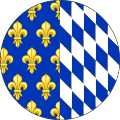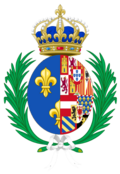| Picture | Name | Father | Birth | Marriage | Became queen | Coronation | Ceased to be queen | Death | Spouse | Arms |
|---|
 | Marie of Anjou | Louis II of Naples | 14 October 1404 | 18 December 1422 | ? | 22 July 1461
husband's death | 29 November 1463 | Charles VII |  |
 | Charlotte of Savoy | Louis, Duke of Savoy | 16 November 1441 | 14 February 1451 | 22 July 1461 | ? | 30 August 1483
husband's death | 1 December 1483 | Louis XI |  |
 | Anne of Brittany | Francis II, Duke of Brittany | 25 January 1477 | 6 December 1491 | 8 February 1492 | 7 April 1498
husband's death | 9 January 1514 | Charles VIII |  |
 | Joan of Valois | Louis XI of France | 23 April 1464 | 8 September 1476 | 7 April 1498
husband's ascension | Not crowned | 17 December 1498
annulment | 4 February 1505 | Louis XII |  |
 | Anne of Brittany | Francis II, Duke of Brittany | 25 January 1477 | 8 January 1499 | 18 November 1504 | 9 January 1514 |  |
 | Mary of England | Henry VII of England | 18 March 1496 | 13 August 1514 (by proxy)
9 October 1514 | 5 November 1514 | 1 January 1515
husband's death | 25 June 1533 |  |
 | Claude of France | Louis XII of France | 14 October 1499 | 18 May 1514 | 1 January 1515
husband's ascension | 10 May 1517 | 20 July 1524 | Francis I |  |
 | Eleanor of Austria | Philip I of Castile | 15 November 1498 | 4 July 1530 | 5 March 1532 | 31 March 1547
husband's death | 25 February 1558 |  |
 | Catherine de' Medici | Lorenzo II de' Medici, Duke of Urbino | 13 April 1519 | 28 October 1533 | 31 March 1547
husband's ascension | 10 June 1549 | 10 July 1559
husband's death | 5 January 1589 | Henry II |  |
 | Mary, Queen of Scots | James V | 8 December 1542 | 24 April 1558 | 10 July 1559
husband's ascension | Not crowned as queen of France | 5 December 1560
husband's death | 8 February 1587 | Francis II |  |
 | Elisabeth of Austria | Maximilian II, Holy Roman Emperor | 5 June 1554 | 26 November 1570 | 25 March 1571 | 30 May 1574
husband's death | 22 January 1592 | Charles IX |  |
 | Louise of Lorraine | Nicholas, Duke of Mercœur | 30 April 1553 | 13 February 1575 | Not crowned | 2 August 1589
husband's death | 29 January 1601 | Henry III |  |
| Picture | Name | Father | Birth | Marriage | Became queen | Coronation | Ceased to be queen | Death | Spouse | Arms |
|---|

































































































